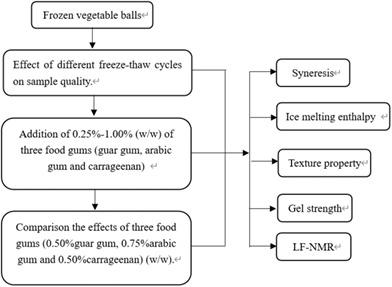当前位置:
X-MOL 学术
›
J. Food Process Eng.
›
论文详情
Our official English website, www.x-mol.net, welcomes your feedback! (Note: you will need to create a separate account there.)
Improving thawed quality of hot‐pot vegetable balls by a freeze–thaw stability control by adding hydrocolloids
Journal of Food Process Engineering ( IF 3 ) Pub Date : 2020-09-09 , DOI: 10.1111/jfpe.13518 Hongyao Jiang 1 , Min Zhang 1, 2 , Yanan Sun 1, 3 , Bhesh Bhandari 4 , Xi Wang 5
Journal of Food Process Engineering ( IF 3 ) Pub Date : 2020-09-09 , DOI: 10.1111/jfpe.13518 Hongyao Jiang 1 , Min Zhang 1, 2 , Yanan Sun 1, 3 , Bhesh Bhandari 4 , Xi Wang 5
Affiliation

|
The aim of this study was to investigate the effects of addition of three different hydrocolloids (guar gum [GG], arabic gum [AG], and carrageenan gum) with the addition amounts of 0.25–1.00% on frozen vegetable balls quality. The qualities of vegetable balls after 0–5 freeze–thaw cycles (FTC) were evaluated in terms of the dehydration rate, thermal property, textural properties, gel strength, and water mobility and distribution. The results showed that the melting property of ice and cross-linked structure of frozen vegetable balls can be ameliorated and the drip loss or dehydration can be slowed down by the addition hydrocolloids, thus improving the freeze–thaw stability. With an increasing number of FTC, loose structure was formed which resulted in to the poor quality of boiled product. The best cooking quality in terms of textural properties (springiness, hardness, and gel strength values), dehydration, and melting enthalpy change after 5 FTC was in the order of balls added with 0.50% GG, 0.75% AG, and 0.50% carrageenan. In conclusion, the overall results showed that the addition of hydrocolloids can improve the freeze–thaw stability and cooking characteristics of vegetable balls. Practical applications: Appropriate addition of hydrocolloids could reduce the negative influence of freeze–thaw cycles on vegetable balls quality by improving physical stability, increasing the content of bound water, and maintaining the dense texture of the product. By an in-depth study of hydrocolloids in food preparation technology, different types hydrocolloids can be used for the improvement of freeze–thaw stability vegetable products, which has potential for a wide application and development prospects.
中文翻译:

通过添加亲水胶体控制冻融稳定性提高火锅菜丸的解冻质量
本研究的目的是研究添加 0.25-1.00% 的三种不同亲水胶体(瓜尔胶 [GG]、阿拉伯胶 [AG] 和角叉菜胶)对冷冻蔬菜丸质量的影响。在 0-5 次冻融循环 (FTC) 后,从脱水率、热性能、质地性能、凝胶强度以及水的流动性和分布方面评估了蔬菜球的质量。结果表明,添加水胶体可以改善冰的熔化性能和冷冻蔬菜球的交联结构,减缓滴落损失或脱水,从而提高冻融稳定性。随着FTC数量的增加,形成松散的结构,导致煮沸产品的质量变差。就质地特性(弹性、硬度和凝胶强度值)、脱水和 5 FTC 后的熔化焓变化而言,最佳烹饪质量按添加 0.50% GG、0.75% AG 和 0.50% 角叉菜胶的球顺序排列。总之,总体结果表明,添加水胶体可以提高蔬菜球的冻融稳定性和烹饪特性。实际应用:适当添加亲水胶体可以通过提高物理稳定性、增加结合水含量和保持产品的致密质地来减少冻融循环对蔬菜球质量的负面影响。通过对水胶体在食品制备技术中的深入研究,不同类型的水胶体可用于提高蔬菜产品的冻融稳定性,
更新日期:2020-09-09
中文翻译:

通过添加亲水胶体控制冻融稳定性提高火锅菜丸的解冻质量
本研究的目的是研究添加 0.25-1.00% 的三种不同亲水胶体(瓜尔胶 [GG]、阿拉伯胶 [AG] 和角叉菜胶)对冷冻蔬菜丸质量的影响。在 0-5 次冻融循环 (FTC) 后,从脱水率、热性能、质地性能、凝胶强度以及水的流动性和分布方面评估了蔬菜球的质量。结果表明,添加水胶体可以改善冰的熔化性能和冷冻蔬菜球的交联结构,减缓滴落损失或脱水,从而提高冻融稳定性。随着FTC数量的增加,形成松散的结构,导致煮沸产品的质量变差。就质地特性(弹性、硬度和凝胶强度值)、脱水和 5 FTC 后的熔化焓变化而言,最佳烹饪质量按添加 0.50% GG、0.75% AG 和 0.50% 角叉菜胶的球顺序排列。总之,总体结果表明,添加水胶体可以提高蔬菜球的冻融稳定性和烹饪特性。实际应用:适当添加亲水胶体可以通过提高物理稳定性、增加结合水含量和保持产品的致密质地来减少冻融循环对蔬菜球质量的负面影响。通过对水胶体在食品制备技术中的深入研究,不同类型的水胶体可用于提高蔬菜产品的冻融稳定性,



























 京公网安备 11010802027423号
京公网安备 11010802027423号